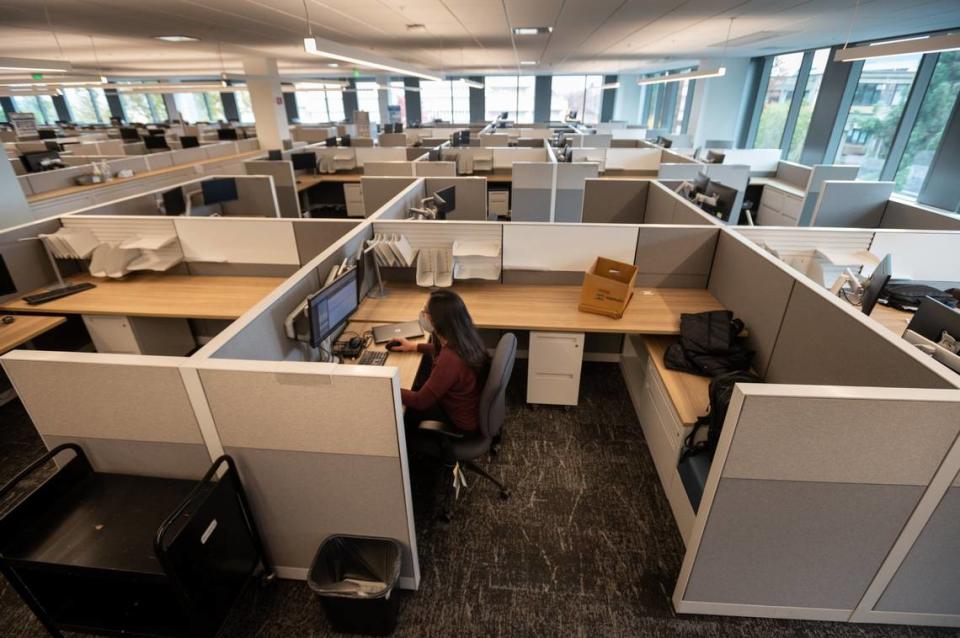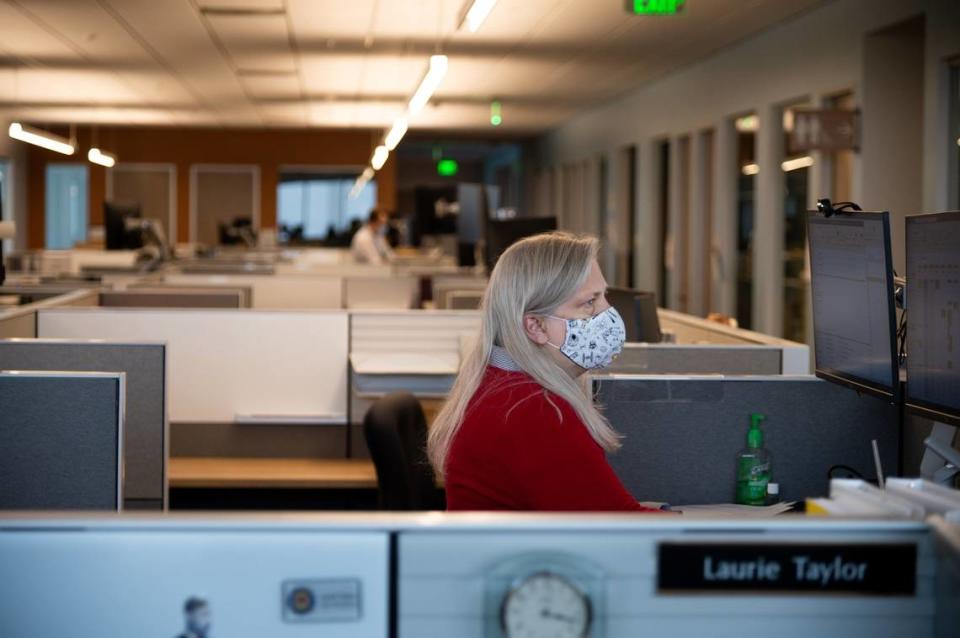California departments with return-to-office mandates praised telework in internal surveys
California shut down the office that tracks telework in state service. But data from two previously unreleased surveys obtained by The Sacramento Bee reveal new insights about departments’ and agencies’ stances on remote work and return-to-office.
More than 110 departments participated in the two statewide surveys, which were conducted in July 2023 and December 2023 by the now-defunct Telework Compliance Office within the Department of General Services. Respondents were asked questions such as, “Has your department’s telework program affected your required office space?” and “Has your department’s ability to retain and recruit employees changed as a result of implementing telework?”
The Bee verified the data’s authenticity with a source who had seen the information before, but who feared retaliation from their employer if identified by name.
Three agencies made headlines earlier this year with public calls to return state workers to the office: the California Environmental Protection Agency, the California Health and Human Services Agency and the Employment Development Department.
But the month before announcing the new two-day in-office rules, these departments highly praised the benefits of remote work in an internal survey conducted by the DGS’ telework office.
At least in early December, CalEPA, CalHHS and EDD did not indicate that they were planning to issue a two-day in-office order. By the next month, something changed.
Here’s how the departments responded to the question, “Will the department’s working arrangements change or stay the same based on the review? Please describe.”
CalHHS: “The working arrangements for CalHHS will remain the same for the foreseeable future to allow for continued workplace flexibility, to provide work/life balance for employees, to be a competitive employer, and for recruitment and retention purposes.”
EDD: “The EDD plans for working arrangements to stay the same but may adjust based on operational needs. Increased in-office work would likely affect current employee retention and the ability to entice new talent.”
CalEPA: “We have seen that continuing to provide telework/hybrid work as an option has proven to be an efficient and effective way to conduct business, support worker retention and recruitment efforts, and has not negatively impacted operations. Based on our initial telework assessment and review of operations, eligible employees who meet criteria established through our telework policy and whose positions can be performed remotely will continue to do so. However, per our telework policy, CalEPA management and staff understand that they can and may be asked to come into the office for work purposes, as needed.”
All three agencies declined to comment beyond the contents of their staff-wide memos released earlier this year.
A total of 110 departments and agencies responded to the December 2023 DGS telework survey. Use the interactive tool below to look up your employer’s responses.
Does in-person work yield more collaboration than telework?
All three departments cited the need for more collaboration and teamwork as reasons for bringing workers back to the office. But in their survey responses, CalEPA, CalHHS and EDD indicated that their employees collaborated quite efficiently through online platforms — even better than before the pandemic.
EDD Director Nancy Farias told staff in a Jan. 25 email: “I believe purposeful time spent in an office will provide more opportunities for engagement between colleagues and increase collaboration, especially for our newer employees.”
In contrast, the EDD’s survey response in December stated: “A greater number of staff collaborate today than historically on assignments.”
“Prior to telework and the use of virtual platforms, collaboration was often delayed or limited due to the availability of meeting rooms along with the expense and inconvenience of travel,” EDD’s response read. “Today, teams that are geographically separated throughout the state can now meet frequently without the extra time and cost associated with travel. This improves the efficiency, collaboration, and diversity of project teams and improves cohesion of the groups throughout the department.”
CalEPA’s response called telework an “efficient and effective way to conduct business” and “support worker retention and recruitment efforts.” The response also cited a recent all-staff telework survey that found most employees felt they had “effective team building opportunities while teleworking” and were able to “build great relationships with their coworkers”. The agency saw a “noted increase in employee engagement” due to boards, departments and offices “engaging their employees in a remote-centric work environment.”
CalHHS conducted its own employee surveys in 2021 and 2023 and found that remote work allowed for “improved employee collaboration,” as well as “better ability to focus” and “increased productivity.”
Departments say telework improved recruitment, productivity and morale
State employees have repeatedly said that telework boosted their mental health and well-being, as well as their productivity. CalEPA, CalHHS and EDD noticed these trends too, the internal survey data shows.
“Hybrid/remote staff generally report that they feel happier, healthier, and safer while performing their daily work,” CalEPA’s response stated. “By embracing the telework and hybrid work model, CalEPA saw an overall increase in staff productivity and efficiency, faster development of policy goals, faster implementation of work product, and better overall employee and program engagement.”
Employees at CalEPA have been especially critical of the impact of commutes on greenhouse gas emissions. The agency itself noted the benefits of keeping workers at home: “As an environmental-based agency, telework supports protecting the environment by reducing emissions and carbon footprint.”
CalHHS’ internal surveys found that telework provided employees with better work-life balance and helped people save money and time commuting. Additionally, since shifting to a telework environment, the agency says it has expanded its reach for both customer service and employee recruitment.
EDD admits that increased in-office work would “likely affect current employee retention and the ability to entice new talent.”
July survey shows telework increased productivity, decreased office space
Out of the 140 responses to the July 2023 “Telework Program Evaluation Survey,” here are some key takeaways:
Productivity: More than 25% of departments (37) indicated employees were more productive after introducing telework. More than half of the departments (71) noted that telework had no influence — negative or positive — on employees productivity.
Office space: More than 45% of responding departments (64) needed less office space as a result of telework. Forty-two departments required the same amount of space after implementing telework as they did before. (In the December survey, CalEPA noted some of its boards, departments and offices saved “upwards of $2.5 million per year” on lease agreements after full telework was introduced.)
Change in costs: More than 25% of departments lowered their operating costs through telework. But 16% of departments saw increased costs after implementing telework. Fifty-two departments did not see a change in costs due to telework.
You can explore the data using the interactive table below and see how your department responded to the survey.
The Bee’s Phillip Reese contributed to this story.
Want state worker news in your inbox? Sign up for our weekly newsletter using the module below or by emailing mmiller@sacbee.com.



